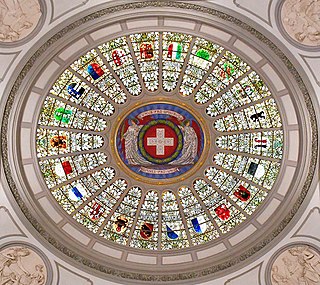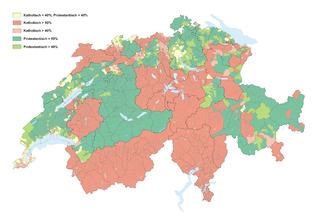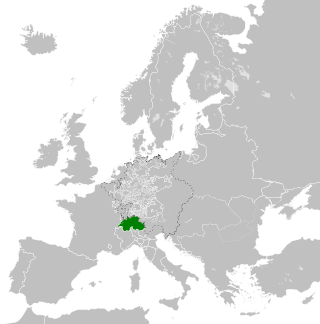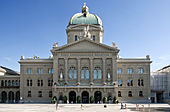
The 26 cantons of Switzerland are the member states of the Swiss Confederation. The nucleus of the Swiss Confederacy in the form of the first three confederate allies used to be referred to as the Waldstätte. Two important periods in the development of the Old Swiss Confederacy are summarized by the terms Acht Orte and Dreizehn Orte.
These are data codes for Switzerland.

Nidwalden or Nidwald is one of the 26 cantons forming the Swiss Confederation. It is composed of eleven municipalities and the seat of the government and parliament is in Stans. It is traditionally considered a "half-canton", the other half being Obwalden.

The Helvetic Republic was a sister republic of France that existed between 1798 and 1803, during the French Revolutionary Wars. It was created following the French invasion and the consequent dissolution of the Old Swiss Confederacy, marking the end of the ancien régime in Switzerland. Throughout its existence, the republic incorporated most of the territory of modern Switzerland, excluding the cantons of Geneva and Neuchâtel and the old Prince-Bishopric of Basel.

Each of the 26 modern cantons of Switzerland has an official flag and a coat of arms. The history of development of these designs spans the 13th to the 20th centuries.
Same-sex marriage has been legal in Switzerland since 1 July 2022. Legislation to open marriage to same-sex couples passed the Swiss Parliament in December 2020. The law was challenged in a referendum on 26 September 2021 by opponents of same-sex marriage and was approved with the support of 64% of voters and a majority in all 26 cantons. The law went into force on 1 July 2022. A provision of the law permitting same-sex marriages performed abroad to be recognised in Switzerland took effect on 1 January 2022. Switzerland was the seventeenth country in Europe and the 30th in the world to allow same-sex couples to marry.

Swiss citizenship is the status of being a citizen of Switzerland and it can be obtained by birth or naturalisation.
The Swiss Confederation comprises the 26 cantons of Switzerland.

The Protestant Church in Switzerland (PCS), formerly named Federation of Swiss Protestant Churches until 31 December 2019, is a federation of 25 member churches – 24 cantonal churches and the Evangelical-Methodist Church of Switzerland. The PCS is not a church in a theological understanding, because every member is independent with its own theological and formal organisation. It serves as a legal umbrella before the federal government and represents the church in international relations. Except for the Evangelical-Methodist Church, which covers all of Switzerland, the member churches are restricted to a certain territory.

Swiss Post is the national postal service of Switzerland. A public company owned by the Swiss Confederation, it is the country's second largest employer with about 54,000 employees. The group is based in Bern and has branches in 25 countries. Roberto Cirillo is its CEO since April 2019. In 2021, Swiss Post was ranked as the world's best by the Universal Postal Union for the fifth time in a row. In December 2022, it was announced Swiss Post has acquired the St. Gallen-based sustainable packaging company, Kickbag GmbH.

The Old Swiss Confederacy, also known as Switzerland or the Swiss Confederacy, was a loose confederation of independent small states, initially within the Holy Roman Empire. It is the precursor of the modern state of Switzerland.

Lesbian, gay, bisexual, transgender, and queer (LGBTQ) rights in Switzerland are some of the most progressive by world standards. Social attitudes and the legal situation have liberalised at an increasing pace since the 1940s, in parallel to the situation in Europe and the Western world more generally. Legislation providing for same-sex marriage, same-sex adoption, and IVF access was accepted by 64% of voters in a referendum on 26 September 2021, and entered into force on 1 July 2022.
The Bürgergemeinde is a statutory corporation in public law in Switzerland. It includes all individuals who are citizens of the Bürgergemeinde, usually by having inherited the Bourgeoisie (citizenship), regardless of where they were born or where they may currently live. Membership of the Bürgergemeinde of a municipality is not to be confused with holding the municipality's citizenship, which, in certain cantons such as Valais, are two distinct legal concepts. Instead of the place of birth, Swiss legal documents, e.g. passports, contain the Heimatort. It is, however, possible for a person to not possess bourgeoisie of the municipality from which they originate; laws relating to these matters vary depending on the canton in which the Bürgergemeinde is located. The Bürgergemeinde also often holds and administers the common property which had been bequeathed or otherwise given to the members of the bourgeoisie. The political communes or municipalities, the parish and the Bürgergemeinde often include the same area but may be separate depending on the relevant cantonal law. With the increase in mobility since the first half of the 19th century, the Bürgergemeinde and the rights associated with citizenship in the municipality have lost most of their meaning. Today, in Switzerland there are nearly 2000 Bürgergemeinden and corporations.

The German-speaking part of Switzerland comprises about 65 percent of Switzerland.
The COVID-19 pandemic in Switzerland is part of the worldwide pandemic of coronavirus disease 2019 caused by severe acute respiratory syndrome coronavirus 2. The virus was confirmed to have spread to Switzerland on 25 February 2020 when the first case of COVID-19 was confirmed following a COVID-19 pandemic in Italy. A 70-year-old man in the Italian-speaking canton of Ticino which borders Italy, tested positive for SARS-CoV-2. The man had previously visited Milan. Afterwards, multiple cases related to the Italy clusters were discovered in multiple cantons, including Basel-City, Zürich, and Graubünden. Multiple isolated cases not related to the Italy clusters were also subsequently confirmed.

Eidgenössische Schützenfeste are the Swiss federal shooting competitions organized by the Schweizerischer Schützenverein since 1824.
There are 26 constituencies in Switzerland – one for each of the 26 cantons of Switzerland – for the election of the National Council and the Council of States.

The Road Traffic Act, is a Swiss federal law that governs traffic on public roads in Switzerland.

The Federal Finance Administration (FFA) (German: Eidgenössische Finanzverwaltung, EFV, French: Administration fédérale des finances, AFF, Italian: Amministrazione federale delle finanze, AFF) is the Swiss federal office responsible for drawing up the Confederation's budget, financial plan and accounts, managing its treasury, and for the financial equalization between the Confederation and the cantons. It is subordinated to the Swiss Federal Department of Finance.













